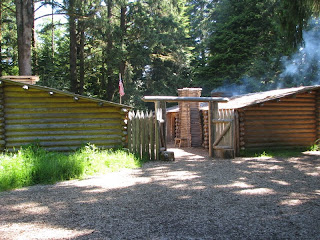July 20-24, 2012 – Flaming Gorge National Recreation Area, Utah
We left Jack’s Gulch Campground on Friday morning and drove
as far as Jensen, UT where we spent the night at the Outlaw RV Park. This park is basically hookups in a gravel
parking lot and the sights are really close together. The park has mostly long
term residents who look like they are oil field workers - we are glad we are
only spending the night here.
The weather here is wonderful, in the mid 80’s during the
day, much cooler than we had in Loveland.
Like all of the Southwest it is very dry here and there is a fire ban in
effect. There is a Forest Service trail
behind the campground that leads to a cliff overlooking Flaming Gorge
Reservoir.
The trail is 2.5 miles round trip so it makes for a great
morning and/or evening hike. Camille and
Cody love taking this hike every day – and some days we go once in the morning and
again in the evening. Often we see deer
along the trail and in or around the RV park.
Flaming Gorge is on the Green River and was named by John
Wesley Powell. The dam stands 455 feet
above the river and extends another 47 feet below the river bottom. One million cubic yards of concrete were used
to build the dam and power plant. The
reservoir stretches 91 miles in length and has about 350 miles of shoreline in
both Utah and Wyoming.
Monday
we took a drive on the Sheep Creek Canyon and Spirit Lake Scenic Backways. On the way to Sheep Creek Canyon we stopped
at Swett Ranch National Historic Site.
Oscar and Emma Swett started the ranch in 1909 and lived here until
1968. The Swetts had three homes on the
ranch, all are still standing. The one room cabin in front of the main house
was moved here in 1909. They lived in
this cabin until 1919 when their 4th child was born. Oscar then built the two-room log cabin on
the right, where they lived until 1929 when they built the main house. The main house had three bedrooms – much more
room for their nine children.
We also stopped at Red Canyon, another canyon named by John
Wesley Powell. This beautiful canyon is
1,700 ft deep and about 4,000 ft wide.
Sheep Creek Scenic Canyon Backway winds through the dramatic
geological formations of the Sheep Creek National Geologic Area.
Every turn in the road revealed more interesting rock
formations.
The Unita Fault runs for more than 100 miles along the north
slope of the Uinta Mountains and is visible in the twisted rock layers. It certainly was a beautiful and colorful
canyon.
We took a side trip to Spirit Lake, a beautiful mountain lake at an elevation of 10,000 feet. The temperature was much colder at this elevation. A cow moose crossed the road in front of us and we were able to get a picture after she came out of the trees down the road.
We really enjoyed this beautiful drive.
Tuesday we did another drive on the Outlaw Country Scenic Byway and Backway. This drive took us from Utah to Wyoming and then into Colorado. We drove through Crouse Canyon, Jessie Ewing Canyon and Brown’s Park. This area has a lot of history as the Ute and Shoshoni, along with fur trappers, spent their winters here enjoying an abundance of game and mild winters. In the 1870’s, John Wesley Powell traveled through the region on two separate trips. Brown’s Park is mostly known for its outlaw history. Its remote location and close proximity to the state boundaries of Wyoming and Colorado gave it lots of appeal for those fleeing the law. Some of the best know outlaws included Butch Cassidy and the Wild Bunch, Matt Warner, Kid Curry, Harry Tracy, among others.
We stopped at the John Jarvie Ranch where John Jarvie
settled in 1880. The 35-acre homestead
once boasted a post office, trading post and river ferry. It was a regular stopping place for travelers
and a secret meeting place for outlaws.
This 2-room dugout is where John and his wife Nellie lived
while their home and general store were being built. It was built into the hillside with a
south-facing entrance overlooking the Green River.
We were told that after the Jarvie’s moved into their home
outlaws used the dugout as a hideout.
The story is that Butch Cassidy once used the dugout as a hideout.
All the comforts of home - two small rooms with a dirt floor and dirt filtering through the ceiling.
The water wheel is a 16-feet diameter replica of the one built by Jarvie and it works. When the water in the river gets a certain height it will turn the wheel and scoop water into the buckets which then dump into a flume to an irrigation canal. It actually started working while we were there.
This cable suspension bridge or “swinging bridge” is one of the few still in operation in the West. You could feel the bridge swinging as we drove across. The original bridge sign read “Load limit - 200 sheep, 30 cattle or 3 ½ ton gross”.
This was another great drive and we always enjoy learning
about the history of the area we are visiting.



















.JPG)

Comments
Post a Comment